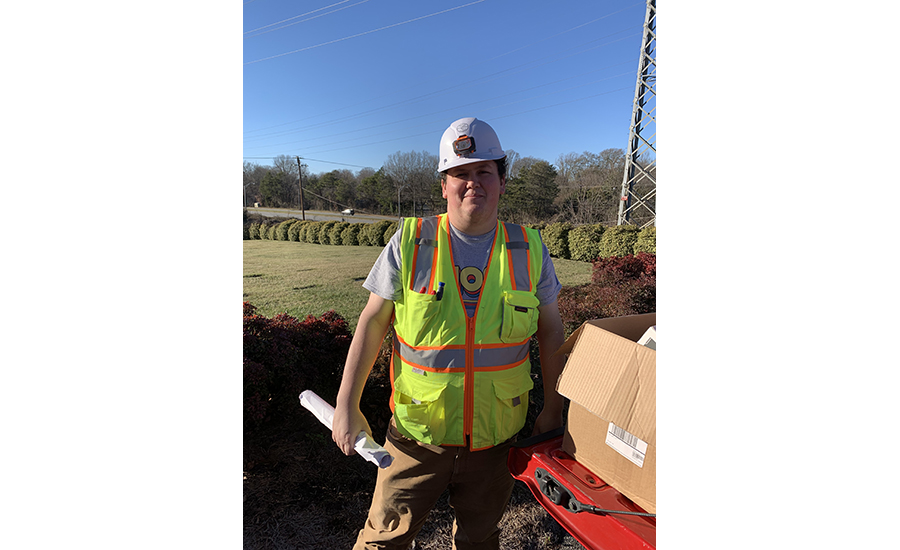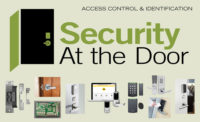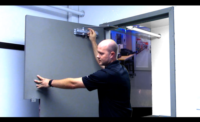Security integrators’ business activity supports the research: substantial progress is expected in access control sales during the next four or five years. One of the segments currently experiencing very robust growth is electronic locks and electrified door hardware. While the coronavirus pandemic may have slowed end-user sales and installations due to the challenges of performing these activities only when it’s safe to do so, it hasn’t deterred end-user demand, integrators say. Yet, with this growth comes challenges both in the complexity of the technology and the way solutions are delivered to the marketplace. Security integrators handle these challenges in a great number of ways.
“Electronic locking devices and door hardware are mission-critical to the functionality of an access control system,” says Dave Sweeney, general manager, Advantech, a Cook & Boardman Company based in Dover, Del., and a Security-Net member company. “We’ve seen this market steadily grow over the past few years, and one of the reasons is because the price point of the battery-powered, integrated handled sets have come down enough to allow customers to deploy card readers and access control on secondary and tertiary doors,” Sweeney says. He notes that 10 years ago it would have cost $5,000 to do a wired card reader door versus $1,200 today, making interior doors much more economically feasible to secure.
Jamie Vos, partner at Security Solutions, a PSA Security integrator based in Bellingham, Wash., concurs that the access control market is expanding into every type of business and including more doors per installation.
Lessons Learned in the Field

IMAGE COURTESY OF ALERT PROTECTIVE SERVICES
Sometimes the best lessons are those learned in the field, and electronic door locks and hardware provide plenty of learning opportunities.
Alert Protective Services once installed the wrong kits for a lock setup for eight doors. “We bought the wrong lock and we bought the wrong door strike — they were for two completely different systems. We installed them and couldn’t figure out why we couldn’t open a single door on there,” says Jared Wasserman at Alert Protective.
He recommends owning up to the mistake immediately with your customer. “But make sure that as you own up to it you have the fix in place and you do it within a 24-hour period. You’re going to be less harped on by the customer and they’re going to appreciate the immediate remedy for it,” Wasserman says. “Make sure that you don’t put the cost for fixing that onto them,” he adds.
Lesson learned: Alert Protective created a curriculum for its sales team that involves having different vendors come to Alert Protective once a month to teach the salespeople about their products and how to sell them. In addition, once every other month Wasserman bring a technician from the field into the office to teach the sales team how a product is installed, how it works, and the way to use it — “so that a mistake like that doesn’t happen down the road,” he says.
In addition, Wasserman says Alert Protective had to learn how to best safeguard itself from initially sending out the wrong product to a job site. “We now have our service manager or our operations manager review all jobs that were sold to make sure that the parts that are with it match what is to be sold or what can be installed. And if any changes need to be done, they’re marked up and turned into the accounting department to order, once everything will jive for the sale to happen.
“Very hard learning lesson that we did, but it taught us to do a different method in our ordering process. And I’d just say, be very mindful that every job is reviewed for accuracy before you order the parts or go and install it. You don’t want to find out when you’re in the field,” he says.

IMAGE COURTESY OF MODERN SYSTEMS
Modern Systems had installed the door hardware for a number of doors in a hallway and when technicians brought the doors online with the access control system, they learned that some of the door contacts weren’t aligned precisely enough to ensure a connection. “There’s a very narrow window of forgiveness,” says Modern Systems’ Nate Jones of the door contacts.
“Turns out we learned two things,” Jones says. “One, we don’t leave a door until we’ve fully tested it. We program the door; we install the hardware on the door — make sure everything works — and then we move on to the next one. It saves you from going back and forth. If you do have an issue, you can correct it immediately while you’re there instead of having to figure out what the issue was and then get your mind back to what you were working on at that door,” he says.
The elements of training your technicians and other positions on electronic locks and door hardware can vary vastly, depending on the part of the market your company serves. A common denominator, however, is integrators taking advantage of manufacturer-provided training.
As an example, Skyline Technology Solutions, which employs around 20 technicians, focuses on the “smarts,” or the electronic components, says Peter Pavlov, because in most cases the company outsources installation of the physical hardware such as strikes, maglocks and exit devices to its locksmith partners. “Our technicians typically will connect all the electronics, put the access control panels in, and do the programming. So, our training doesn’t focus a lot on the
actual door strikes and maglocks. It focuses a lot on wiring, such as how you would install a request-to-exit (REX) or a door contact, or how you wire the electronic locks to work with the access control system,” Pavlov says.Also, because Skyline focuses on intelligent locks, it devotes training time to deploying and servicing the locks. Skyline stages most of the equipment for a job in its lab, rather than in the field. “We bench test and program the smart locks as much as we can in our lab, so techs are not fumbling with them and trying to read the manual on the job site, especially with all the COVID-19 restrictions. We’re trying to minimize any exposure, if possible,” he explains.
“The customer obviously has to provide a lot of IT information, like IP addresses. If we’re using Wi-Fi locks, they have to give us the encryption keys for their Wi-Fi in advance. In very few cases, where it’s a super-fast installation, then we have to do it onsite. But if we do our best to stage everything and make the system as plug-and-play as possible, then you’re just installing the hardware and once you flip the switch, everything just comes online,” he describes.
At Pasek Security, David Alessandrini emphasizes, “There is a considerable amount of training curriculum for access control and wireless locks that is available online and we leverage these resources regularly. We also provide some training through our parent company’s online learning system and individual manufacturers’ online learning centers.” He says most of the online courses require a test or quiz at completion and some also provide certification.
His company also sends technicians to manufacturers’ training facilities for certified training on programming and adjusting various speed, mode, and safety applications in door operators. Automatic door training centers provide American Association of Automatic Door Manufacturers (AAADM) certified training. The program for installers and service technicians is designed to improve and promote safety for pedestrian automatic doors, Alessandrini says. “We require our senior automatic door technicians to obtain and maintain current a AAADM certification.”
“We have to be good at all types of hardware to install it in new applications, but also we have to be good at troubleshooting and servicing it after the fact. When we install a card reader on the door and the door doesn’t work, the customer calls us first, regardless of the problem. They call us because we have a service and support arm that takes care of them and they believe we are responsible for all of the door. We want to service these customers with a first-call resolution. We have a lab and regularly have our technical staff engage in internal training and we invest in professional training opportunities because we believe that’s part of our job,” Sweeney says.
Convenience & Control
Around the spring of 2021 was when building owners and operators fell into a more regular pattern of usage among tenants in their buildings, resulting in the knowledge of when the buildings would be open and closed, how they would be accessed, and what type of access control would be needed, says Peter Pavlov, principal architect for physical security, Skyline Technology Solutions, Glen Burnie, Md. “Access control became a more vital part of securing the building by tracking who enters the building — also how the buildings are used, adding more remote-control capabilities. I can unlock a building or lock a building more easily, remotely, without actually driving and keying everything. So, that’s what I think started to drive this growth in access control,” Pavlov says.
Along with other security disciplines, “Having access control as a category is certainly a growing trend, especially with what’s going on in the world today with COVID and people working remotely,” says Sam Korff, principal, JM Resources, King of Prussia, Pa. “Being able to open doors and give instant access is all very important, and so we’re growing this part of our business. Because people are working remotely, and so not everyone is on staff, not everyone wants to manage keys; they want to do it with an app or smart phone, so having electronic door strikes for that reason is very important.”
David Alessandrini, vice president of Boston-based Pasek Security, a Security-Net member, agrees. “Our business with electronic locking devices and door hardware is increasing, as is our backlog. There is an increase in the installation of wireless access control locks and cloud-hosted systems, as well as multifamily housing using cloud-based access control for tenant units and common area doors. There is a shift to more automatic-operated doors and not just for [ADA], but overall hands-free operation.”
Manufacturers aren’t slowing down in their development of electronic locks and associated hardware, especially when it comes to wireless devices. However, the smarter and more integrated these devices become, the more difficult they can be to install and program accurately. Security integrators — many of whom did not specialize in door devices before now — may find themselves getting behind in the skill level required to outfit a door electronically and provide this piece of an access control system to end users.
To capture some of the opportunities occurring in the door lock and hardware market, integrators can partner with locksmiths who specialize in the newer technology; they can expand their education and elevate their skill level; and they can and should develop best practices for their technical staff to use.
— MARK DUATO, Cook & Boardman
"The manufacturers are not going to take their foot off the gas; they’re going to continue to innovate, and they’re going to push more and more technology down to the opening. So, either the integrators can get with the program and become better at the opening or they’ll lose to someone who is better at the opening."
Total Opening Solutions
“As more and more sophisticated access control openings are being specified for projects — and oftentimes it’s the manufacturer that specifies their technology on these projects — the integrator of today needs to be better prepared to deliver those openings in an efficient way, but also in a profitable way,” describes Mark Duato, senior vice president of strategic integration solutions, The Cook & Boardman Group, Winston-Salem, N.C. “The default position for a typical integrator is to say, ‘We’ll do it the old way. We’ll rip those locks out and we’ll put in a strike or a maglock and a reader on the wall.’ That’s a very typical integrator response because they don’t have the expertise to do the more sophisticated openings.
“The manufacturers are not going to take their foot off the gas; they’re going to continue to innovate, and they’re going to push more and more technology down to the opening. So, either the integrators can get with the program and become better at the opening or they’ll lose to someone who is better at the opening, who does have that expertise. But oftentimes they’re leaving margin dollars and service and support revenue for these access control projects to someone else who is better prepared,” Duato believes.

Tolliver Quaco, installation technician with Skyline Technology Solutions, installs a HID iCLass R10 reader and HES 1600 strike. IMAGE COURTESY OF SKYLINE TECHNOLOGY SOLUTIONS
The Cook & Boardman Group is positioning itself to capture those opportunities by building a “family of companies” that can address total opening solutions. It recently has acquired security integrators — many of which are ranked on SDM’s Top Systems Integrators Report — including A3 Communications, Advantech, 3Sixty Integrated, Bass Security, and BlueViolet Networks. Cook & Boardman is a distributor of commercial doors, frames and hardware, electronic access control equipment and specialty products; and provides full systems integration services through its newly acquired integrators.
Duato explains, “The uniqueness of what we’re doing is the fact that we have in our traditional doors, frames and hardware business — which is a bigger piece of our business — a lot of expertise around the opening. In our integration businesses, we have a lot of expertise around the systems integration business. My function is to essentially bring our businesses together to serve these end customers through the construction management of delivering opening solutions, all the way through to the delivery of integrated products with best-of-class brands and best-of-class software platforms, and also providing aftermarket services tied to those.”
Lenexa, Kan.-based American Direct Procurement Inc. uses a similar approach to the market, which it describes as providing “complete control at every door” and “a seamless experience for our users at every step — from pre-construction, logistics, installation to integration, access control, and field service.” Like The Cook & Boardman Group, American Direct combines Division 8 and Division 28 product, service, and expertise to deliver integrated security solutions at the physical door opening.
But these are far from the only solutions available to end users of door security solutions. For other security integrators, the right approach is partnering on a local level. Considering the challenges integrators confront both with keeping up with new technology and the inherent trickiness of performing work to a door, many integrators partner with locksmiths.
“We hire experienced locksmiths to install the hardware and do on-the-job training with our other technicians,” Vos explains. “We also use manufacturers and the resources they provide.”
Best Practices in Door Security
Security integrators gain an advantage by developing a standardized approach to access control and door security solutions. These are some of their best practices:
- "If the door is not a standard door — such as a glass door or extra-thick door — verify that it should be done by a sub-contracted locksmith,” explains Jared Wasserman, CEO/CFO, Alert Protective Services, Chicago. “We can quote it for them because we have good relationships with plenty, or they can go to their own locksmith that they prefer to use. But we will have them take care of that cost because I’m not going to break something that we wouldn’t know how to fix or would cost us a lot more money to correct if we damaged."
- For anyone who installs electronic locking devices and door hardware, the hard part is getting the right hardware to the site with the technicians, Sweeney thinks. “There are so many different commercial door standards and, to complement these standards, we have a similar quantity of electronic locking hardware standards. There’s a time when you need a mortise electronic strike or cylinder strike; or there are times when you have to use an electronic lever set; and other times when you have to use magnetic locks, which have many mounting brackets that may be required. You must understand if the hardware requires a fire rating,” he says. Sweeney emphasizes the importance of ensuring that the team member who evaluates the door then selects the appropriate locking hardware, “So our technical people can be successful in deploying the solution.”
- One of the most essential tools that Modern Systems uses are templates for the doors they are installing locks and hardware on — not the paper templates that come with the new locks and hardware, but sturdier ones that Modern Systems designed and then had fashioned by a metal fabricator. “We have metal templates for installing cylindrical and mortise locks on doors. For the mortise, you can walk up to the door, slide the template onto the door, and it’s got every hole you need right there. You cannot miss-drill,” explains David Hudson, sales manager at Modern Systems Inc., Yadkinville, N.C.
- “If you’re replacing a door that already has a mortise handset in it with a wireless-style lock, it has the connection points to connect the template to the door using the same mounting points as the mortise that was already in there. So, everything lines up perfectly when you’re done,” explains Nate Jones, project manager at Modern Systems Inc. “Those in and of themselves have probably cut even the manufacturer’s suggested time down tremendously. In some cases, if the door is in good shape and it’s not anything crazy, you’re talking almost half the time, if you do it correctly, by using these.” The templates paid for themselves within the scope of just one job, he says.
- At a high level, Korff says, it’s important to provide sufficient wiring and connectivity, even in locations where the customer doesn’t necessarily want an electronic door now but may want it later. “When we’re running wires throughout a building in new construction, we want to get as much wire in, because clients’ budgets change, their desires change — but if we can get that smart infrastructure in, then they can go back at a later point and expand those systems without hassle,” Korff says.
- For specific devices, Vos suggests doing the following:
- Door switches — “Make sure to know the code on mounting heights. Also look at the way the door swings and imagine yourself in a wheelchair pushing the button and getting into the opening.”
- Electromagnetic door locks — “Pick one manufacturer and stick with them; this reduces errors and can help in consistently delivering the best possible experience.”
- Door strikes — “Don’t skimp on tools and jigs. Also make sure to determine if the frame is concrete-filled before going out, so you plan the appropriate amount of time and ensure you are specifying the correct strike.”
- Electronic locks — “Make sure you can get wires to them. The replacement should go very easily if it is like-for-like. I would make sure to have experience or specific training on mortise-style locks.”

Greg Rogers, owner of Safe Lock Security Solutions Inc., locksmith partner to Skyline Technology Solutions, installs a Sargent IN220 PoE lock. IMAGE COURTESY OF SKYLINE TECHNOLOGY SOLUTIONS
Pavlov says the major change in access control over the last few years is smart locks. “[They are] drastically changing the architecture of the system and require a lot more IT knowledge. It’s not just low-voltage, open/closed circuits anymore; you have an intelligent device, which is sitting on your network at each door. You still need the locksmith skills … to install the device. But now, you also need IT knowledge to troubleshoot it, because most of the issues are [things like] why the lock is not talking to the Wi-Fi system or why it’s not communicating on the customer network, which are preventing the door from working. So, definitely invest in training your access control techs on at least the basics of IT and networking so they will have a better understanding how those devices work,” Pavlov advises.
Korff says these systems can do a lot of very cool things if integrated with other systems, but it’s important to understand what their end use is, and to provide guidance and education about them. He recommends having a dedicated project manager on all door security jobs and documenting what the end system is going to look like and what its functionality is.
“When you’re talking access control, you want to make people’s lives easier — that’s the whole goal,” Korff says. “Electronic doors are more expensive than manual doors, so you have to have to understand what the benefit is. The benefit is really allowing people to manage buildings remotely. If you can make their lives easier, you’re going to have a very successful business.”





